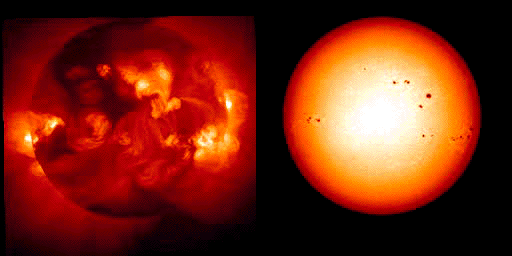|
Modeling the Magnetic Sun to Forecast Space Weather
Like all stars, our Sun has many distinct layers. The deepest layer we can see optically is
the photosphere and it is sometimes referred to as the solar surface. However, the Sun is
completely gaseous and there is no solid surface like here on Earth. Above the photosphere
the gas becomes more and more tenuous until the outermost atmosphere is reached, which is
called the corona.
The Sun's magnetic field, now thought to be generated mainly in a thin zone about one
third of the way down towards the center, penetrates all layers. Scientists are working
to model the magnetic field from one layer to the next to help unravel the mysteries of
how the magnetic field is generated, how it stores energy, and how it contributes to the
dynamic activity we observe on the Sun.

Image Credit: Yohkoh
Dark sunspots in the photosphere of the Sun are evidence strong or concentrated of magnetic
field there. You can see these dark spots in the image on the right. In the corona of the
Sun magnetic fields reveal themselves through the hot gas which follows the twists and turns
of the field itself. These magnetic field loops or arcades are visible in the lefthand image
above, which was taken at the same time as the other. The illuminatd loops are often rooted
in or near sunspots. These or neighboring structures sometimes erupt, as seen in an
animated GIF movie (1763 k),
causing episodes of disturbed "space
weather"
Solar scientists involved in this research effort are using
magnetic evidence available from observations of the photosphere as a base on which to build
a model of magnetic field activity in the corona. Coronal activity directly impacts Earth's
space weather, which affects our satellites and our communications networks, so a Coronal
Weather Report for the Sun has practical applications. We hope the activities and tutorials
presented here will help you develop a better understanding of the Sun's complicated magnetic
field and how it affects life on Earth.
|

